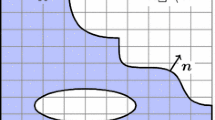Abstract
A meshless approach to the analysis of arbitrary Kirchhoff plates by the Element-Free Galerkin (EFG) method is presented. The method is based on moving least squares approximant. The method is meshless, which means that the discretization is independent of the geometric subdivision into “finite elements”. The satisfaction of the C 1 continuity requirements are easily met by EFG since it requires only C 1 weights; therefore, it is not necessary to resort to Mindlin-Reissner theory or to devices such as discrete Kirchhoff theory. The requirements of consistency are met by the use of a quadratic polynomial basis. A subdivision similar to finite elements is used to provide a background mesh for numerical integration. The essential boundary conditions are enforced by Lagrange multipliers. It is shown, that high accuracy can be achieved for arbitrary grid geometries, for clamped and simply-supported edge conditions, and for regular and irregular grids. Numerical studies are presented which show that the optimal support is about 3.9 node spacings, and that high-order quadrature is required.
Similar content being viewed by others
References
Belytschko, T.; Gu, L.; Lu, Y. Y. 1994: Fracture and crack growth by element-free Galerkin methods. Modelling Simul. Mater. Sci. Eng. 2: 519–534
Belytschko, T.; Lu, Y. Y.; Gu, L. 1994: Element-free Galerkin methods. International Journal of Numerical Methods in Engineering 37: 229–256
Belytschko, T.; Organ, D.; Krongauz, Y. A coupled finite element-element-free Galerkin method. Computational Mechanics, submitted.
Bunch, J.; Kaufman, L.; Parlett, B. 1976: Decomposition of a symmetric matrix. Numerische Mathematik, 27: 95–109
Carpenter, N.; Belytschko, T.; Stolarski, H. 1986: Locking and shearing factors in C 0 bending elements. Computers and Structures, 22: 39–52
Cleveland, W. S. 1993: Visualizing data. AT&T Bell Laboratories, Murray Hill, N.J.
Dhatt, G. S. 1969: Numerical analysis of thin shells by curved triangular elements based on discrete Kirchhoff hypothesis. In: Rowan W. R. and Hackett R. M., (eds.), Proc. Symp. on Applications of FEM in Civil Engineering, Nashville, Tennessee. Vanderbilt University
Hein, P. 1993: Diffuse element method applied to Kirchhoff plates. Technical report, Dept. Civil Engrg, Northwestern University, Evanston, Il.
Jirousek, J.; Lan, Guex, 1986: The hybrid trefftz finite element model and its application to plate bending. International Journal of Numerical Methods in Engineering 23: 651–693
Kansa, E. J. 1990: Multiquadrics — a scattered data approximation scheme with applications to computational fluid dynamics: I. Surface approximations and partial derivative estimates. Computers and Mathematics with Applications 19: 127–145
Kansa, E. J. 1990: Multiquadrics — a scattered data approximation scheme with applications to computational fluid dynamics: II. Solutions to parabolic, hyperbolic and elliptic differential equations. Computers and Mathematics with Applications 19: 147–161
Krongauz, Y.; Belytschko, T. 1995: Enforcement of essential boundary conditions in meshless approximations using finite elements. Computer Methods in Applied Mechanics and Engineering, submitted
Lancaster, P.; Salkauskas, K. 1986: Curve and surface fitting: an introduction. Academic Press, London, Orlando
Liszka, T. 1984: An interpolation method for irregular net of nodes. International Journal of Numerical Methods in Engineering 20: 1599–1612
Liu, W. K.; Sukky, Jun; Li, S.; Adee, J.; Belytschko, T. 1995: Reproducing kernel particle methods for structural dynamics. International Journal of Numerical Methods in Engineering, accepted for publication
Lu, Y. Y.; Belytschko, T.; Gu, L. 1994: A new implementation of the element free Galerkin method. Computer Methods in Applied Mechanics and Engineering 113: 397–414
Monaghan, J. J. 1982: An introduction to SPH. Computer Physics Communications 48: 89–96
Nayroles, B.; Touzot, G.; Villon, P. 1992: Generalizing the finite element method: diffuse approximation and diffuse elements. Computational Mechanics 10: 307–318
Qian, S.; Weiss, J. 1993: Wavelet and the numerical solution of partial differential equations. Journal of Computational Physics 106: 155–175
Strang, W. G.; Fix, G. J. 1973: An analysis of the finite element method. Prentice-Hall, Englewood Cliffs, N.J.
Timoshenko, S.; Woinowsky-Krieger, S. 1959: Theory of plates and shells, 2d ed. McGraw-Hill, New York
Author information
Authors and Affiliations
Additional information
Communicated by S. N. Atluri, 18 August 1995
Dedicated to J. C. Simo
Rights and permissions
About this article
Cite this article
Krysl, P., Belytschko, T. Analysis of thin plates by the element-free Galerkin method. Computational Mechanics 17, 26–35 (1995). https://doi.org/10.1007/BF00356476
Issue Date:
DOI: https://doi.org/10.1007/BF00356476




